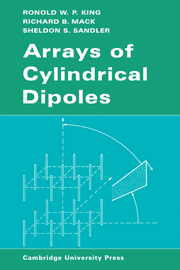Book contents
- Frontmatter
- Contents
- Preface
- CHAPTER 1 INTRODUCTION
- CHAPTER 2 AN APPROXIMATE ANALYSIS OF THE CYLINDRICAL ANTENNA
- CHAPTER 3 THE TWO-ELEMENT ARRAY
- CHAPTER 4 THE CIRCULAR ARRAY
- CHAPTER 5 THE CIRCUIT AND RADIATING PROPERTIES OF CURTAIN ARRAYS
- CHAPTER 6 ARRAYS WITH UNEQUAL ELEMENTS; PARASITIC AND LOG-PERIODIC ANTENNAS
- CHAPTER 7 PLANAR AND THREE-DIMENSIONAL ARRAYS
- CHAPTER 8 TECHNIQUES AND THEORY OF MEASUREMENT
- Appendix I Tables of ΨdR, T(m) or T′(m) and self- and mutual admittances for single elements and circular arrays
- Appendix II Summary of the two-term theory for applications
- Appendix III Summary of formulas for the curtain array
- Appendix IV Tables of admittance and impedance for curtain arrays
- Appendix V Programme for Yagi-Uda array
- References
- List of symbols
- Index
- Frontmatter
- Contents
- Preface
- CHAPTER 1 INTRODUCTION
- CHAPTER 2 AN APPROXIMATE ANALYSIS OF THE CYLINDRICAL ANTENNA
- CHAPTER 3 THE TWO-ELEMENT ARRAY
- CHAPTER 4 THE CIRCULAR ARRAY
- CHAPTER 5 THE CIRCUIT AND RADIATING PROPERTIES OF CURTAIN ARRAYS
- CHAPTER 6 ARRAYS WITH UNEQUAL ELEMENTS; PARASITIC AND LOG-PERIODIC ANTENNAS
- CHAPTER 7 PLANAR AND THREE-DIMENSIONAL ARRAYS
- CHAPTER 8 TECHNIQUES AND THEORY OF MEASUREMENT
- Appendix I Tables of ΨdR, T(m) or T′(m) and self- and mutual admittances for single elements and circular arrays
- Appendix II Summary of the two-term theory for applications
- Appendix III Summary of formulas for the curtain array
- Appendix IV Tables of admittance and impedance for curtain arrays
- Appendix V Programme for Yagi-Uda array
- References
- List of symbols
- Index
Summary
Fundamentals—field vectors and potential functions
Radio communication depends upon the interaction of oscillating electric currents in specially designed, often widely separated configurations of conductors known as antennas. Those considered in this book consist of thin metal wires, rods or tubes arranged in parallel arrays of circular or planar form. Electric charges in the conductors of a transmitting array are maintained in systematic accelerated motion by suitable generators that are connected to one or more of the elements by transmission lines. These oscillating charges exert forces on other charges located in the distant conductors of a receiving array of elements of which at least one is connected by a transmission line to a receiver. Fundamental quantities upon which such an interaction depends are the electromagnetic field and the driving-point admittance. But these are completely determined by the distribution of current in the elements of an array. In this first chapter the basic electromagnetic equations are formulated and applied to simple antennas and arrays in the conventional manner which is based on assumed rather than actual currents. The limitations of this approach are pointed out as an introduction to the more accurate formulation of the theory of antennas and arrays that is presented in subsequent chapters.
- Type
- Chapter
- Information
- Arrays of Cylindrical Dipoles , pp. 1 - 45Publisher: Cambridge University PressPrint publication year: 1968



